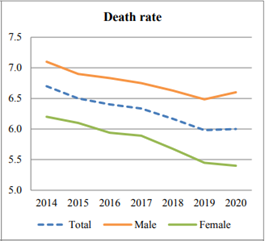Context
- The inconsistencies in death estimates provided by the recently released SRS Statistical Report 2020 call into question its accuracy and quality and further complicate the exercise to estimate the COVID-19 death toll.
About Sample Registration System (SRS)
- Description: The Sample Registration System (SRS) is a large-scale demographic survey for providing reliable annual estimates of Infant mortality rate, birth rate, death rate and other fertility & mortality indicators at the national and sub-national levels.
- It estimates actual number of births and deaths in India through this survey-based process.
- Initiation: It was started in 1964-65 by the Registrar General of India.
SRS Statistical Report 2020 death data
- National basis: The Crude Death Rate (CDR) at national level is 6.0 varying from 6.4 in rural to 5.1 in urban areas.
- State estimates: The maximum CDR has been reported for Chhattisgarh (7.9) and the minimum for Delhi (3.6).
- Trend: During the last five years, the decline in National CDR has been to the tune of 0.5 points.
- Gender difference: The corresponding decline in female CDR is 0.7 points whereas in male CDR it is 0.3 points.

Limitations of SRS
- Doubtful credibility: While the SRS is considered more reliable, however, in several States, the registered deaths exceed the estimates provided by the SRS.
- Also as per the latest SRS report, the death rate was 6.0 per 1,000 in 2020. It is strange to witness that in a year affected by the pandemic, the estimated death rate remained unchanged from 6.0 in 2019.

- Contrasting picture with CRS: Also, by contrast, the Civil Registration System (CRS) showed that India had an estimated 8.2 lakh excess deaths in 2020. However, the SRS failed to capture this excess morality
- About Excess Deaths: Excess deaths were calculated as the difference between the registered deaths in 2020 and the average number of deaths registered in 2018 and 2019.
- These excess deaths were 5.5 times the official COVID-19 death toll recorded in 2020.
- Thus while the CRS shows excess mortality, the SRS, which is also used to assess the completeness of registration in the CRS, failed to capture this despite an increase in the death rate of males and females.
- State wise inconsistencies: For example, all three states namely Madhya Pradesh, Assam and Himachal Pradesh recorded a fall in the total death rate in 2020 even as the death rates of males and females showed a rise.
- In Himachal Pradesh, for instance, the death rate of males jumped from 7.1 to 8.1 and for females, it rose from 3.9 to 5.5, but the total death rate declined from 6.9 to 6.8 in 2020.
- In Karnataka, the death rate remained constant even as the female death rate rose significantly in 2020.
About Civil Registration System (CRS)
- Description: Civil Registration System (CRS) is the unified process of compulsory and universal recording of the vital events i.e. Birth, Death & Still Birth at the place of occurrence on continuous and permanent basis.
- The CRS data show the births and deaths which were registered, not the actual number of births and deaths.
- List: The CRS falls under the Concurrent list of the Constitution of India.
- Authority: The Registrar General, India (RGI) at the Central Government level coordinates and unifies the activities of registration throughout the country.
- However, the implementation of the statute is vested with the State Governments.
- Significance: The data generated through a complete and up-to-date CRS is essential for socio-economic planning.
Limitation of CRS
- Exceeding time limit: The normal period of reporting the event is 21 days from its occurrence.
- But not all deaths are registered in India and a significant number is recorded beyond the prescribed time limit of 21 days.
- These types of events can be registered after the normal period under delayed registration provisions of Registration of Births and Deaths (RBD) Act, 1969.
- Issues with CRS numbers: For instance, some States such as Uttar Pradesh and Bihar have historically lower registration rates compared to other States.
- According to data from the CRS, Uttar Pradesh registered 8.73 lakh deaths in pandemic year 2020, down from 9.44 lakh deaths registered in 2019.
- The death registrations in U.P. progressed slowly from about 47 per cent in 2011 to 63 per cent in 2019, while the national average jumped from 67 per cent to 92 per cent in the same period.
- In percentage terms, Telangana registered 11 per cent decline in in death registrations in 2020 as compared to a 7.5 per cent fall in UP.
- Ambiguous undercounting: States such as Bihar, Maharashtra and West Bengal had a high burden of excess mortality, but when compared with the official COVID-19 toll, Bihar, Assam and Madhya Pradesh had the highest undercount factor.










